Name of Indian Vegetarian Diet
In this post, you will learn about each major food group in the Indian vegetarian diet. You will also get a sense for the role of culture in the diet, since in India, food and culture are very much intertwined.
In the United States, Indian food is not generally represented well at restaurants, and some people have a bad experience. Let me share with you a truth. It is hard to find good Indian food at restaurants.
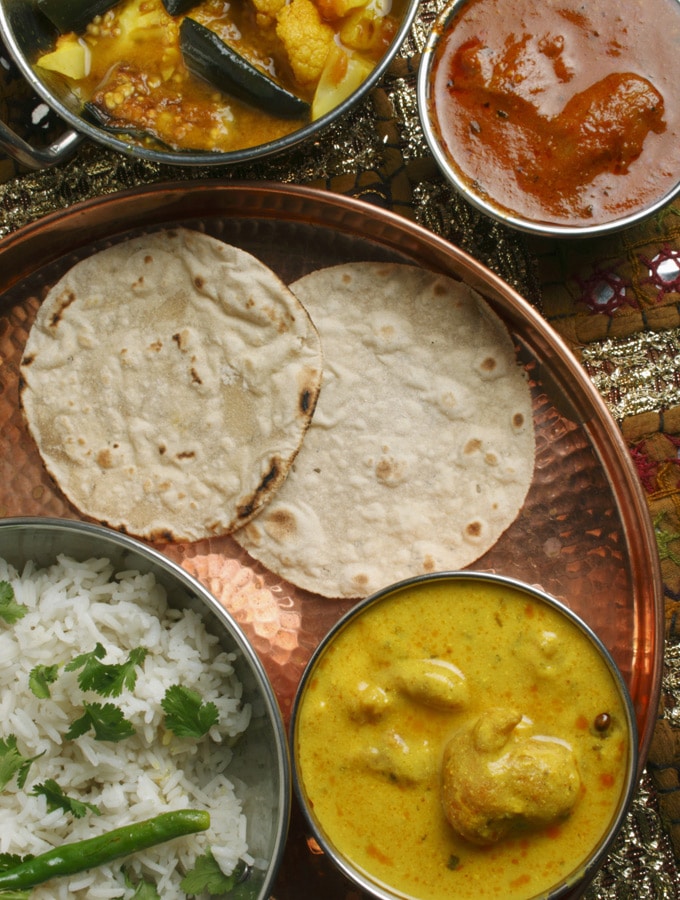
Personally, I love Indian food, and flavors like turmeric, tamarind and cardamom are too wonderful. Cooking Indian food at home can be a life-changing experience. It was for me.
I sincerely wish to introduce you to this incredible cuisine. I hope that this post will help you to feel more confident approaching the recipes in the Buttered VegIndian recipes section. Enjoy the ride!
In A Nutshell
The Indian vegetarian diet is known as lacto-vegetarian. It includes dairy, but excludes eggs. Most vegetarians in India avoid eggs, which has spawned a large egg-free baking dessert repertoire.
Indian food is almost always cooked. The cuisine does not include much in the way of fresh salads, and raw vegetables are generally treated as condiments.
Fruit is eaten fresh, but surprisingly it is not a focus. Even with desserts, generally only dried fruits are used. Preserved fruit is usually pickled and spicy, rather than sweet.
Now, I suspect the reason fresh food is not prevalent is due to the fact that India lacks cold refrigeration and storage.
Farmers and suppliers must get fresh produce to market quickly before it goes bad, and fruits and vegetables with a longer shelf life are therefore favored.
Grains, pulses, dairy, and vegetables are the main food groups in the Indian vegetarian diet. Nuts and seeds make regular appearances, mainly cashews, almonds, and sesame seeds.
And spices, of course. Masala magic is covered in the last section of this post.
Indian cuisine is rich in complex carbohydrates, and many of us in the West do not prefer the cuisine for this reason.
Carbohydrates are the latest food enemy in the media, despite how grains have sustained countless generations. Click To Tweet
Carbohydrates are among the latest food enemies in the media, despite the fact that grains have sustained countless generations. My belief is that how we feel about food is a matter of perspective, and of starting points. We have access to such abundance in the West that we are used to having more diversity in our food.
At my home, we seek a balance. I often add a variety of new vegetables that grow locally, such as leafy greens and summer squash, and include fresh green salads and fruit with meals.
This way, I can still enjoy the exciting flavors of Indian cuisine, along with an enhanced nutritional profile. I would encourage anyone with the means to approach the cuisine by adding an abundance of fruits and vegetables. Following the recipes on Buttered Veg, you will experience this approach.
But first, let's get to the fundamentals.
Get a Guide to Indian Ingredients, and Indian Ingredient Substitutions.
Indian Grains
The most commonly eaten grain in India is rice, and its roots are deeply spiritual.
According to Vedic texts (written between 1500 BCE and 500 BCE), the entire universe is contained within a single grain of rice.
For another perspective, Maya Tiwari, an Ayurvedic teacher, author, and health activist, explains in "Life of Balance," that the three major components of rice mirror the living universe.
The husk, bran/germ, and endosperm symbolize the cosmic psychic energies of sattva, rajas, and tamas. These energies in turn mirror the harmony or protection, dynamism, and inertia of the living universe.
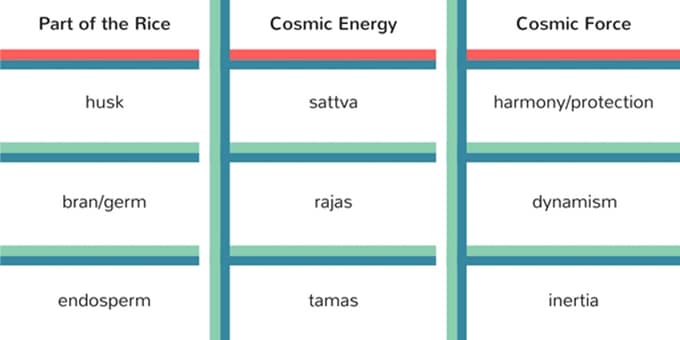
Historically, hulled brown rice, which includes the bran and germ, was eaten. It was during the time of Mughul rule in India, beginning in the early 16th century, that polished white rice was popularized.
Today, white rice is widely consumed. Only the poorest of villagers still eat brown rice regularly.
Allow me to digress and talk about white versus brown rice for a minute.
In the West, white rice has been demonized by some as a source of pure sugar, otherwise known as a simple carbohydrate.
However, there is also another camp that demonizes brown rice for containing so-called anti-nutrients called phytates, which can inhibit mineral absorption.
You may be surprised to know thatIndia's science of life, Ayurveda, recommends white rice. It recognizes that white rice is easier to digest. It considers white rice a cleansing and healing food.
Ayurveda values good digestion as the key to good health, so this makes sense. Due to the higher nutritive content of brown rice, and the fiber, it is not as easy to digest.
If you are unsure about what to choose, I suggest you try eating the different types of rice and seeing how you feel.
I did a little research on rice nutrition, and the main similarities and differences between white rice and brown rice are as follows.
Brown rice has fiber, natural fat, and B vitamins, that white rice does not have. Both have similar caloric and protein counts.
Seasonality is another important consideration. Ayurveda recommends eating brown rice in the winter, when digestive strength is naturally stronger based on the seasonal variance.
In my household, we consume both brown and white rice.
Rice In India
There are tens of thousands of varieties of rice, but in Indian cuisine three are most commonly used. These are basmati rice, patna rice, and ponni rice, all of which are grown in India.
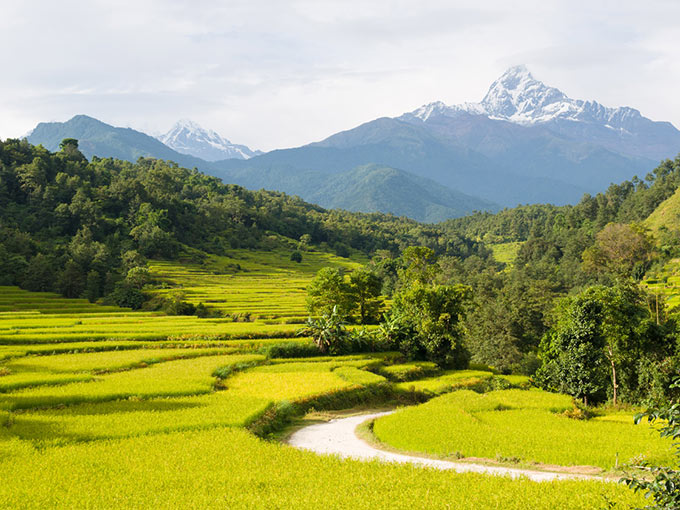
Basmati rice is the most prized, with its long, slender shape that elongates when cooked. In the ancient Sanskrit language, basmati means "the fragrant one." Basmati has a lovely smell and a nutty flavor.
Basmati rice is grown in the northern states of India, and in Pakistan, with the best varieties coming from the Himalayan foothills terroir. In the West, it is very common to choose basmati rice with Indian food.
Learn: How To Make Perfect Basmati Rice
Patna rice is closely related to basmati in terms of it being long-grained, but it is not as fragrant and flavorful. It is less expensive to purchase. It is mostly grown in the state of Bihar, in the Indo-Gangetic plains.
Ponni rice is a South Indian variety, and it is used specifically for making idlis and dosas, which are staples of the South Indian regional cuisine. It is medium-grained, sold par-boiled or raw, and contains a less starch than other rices.
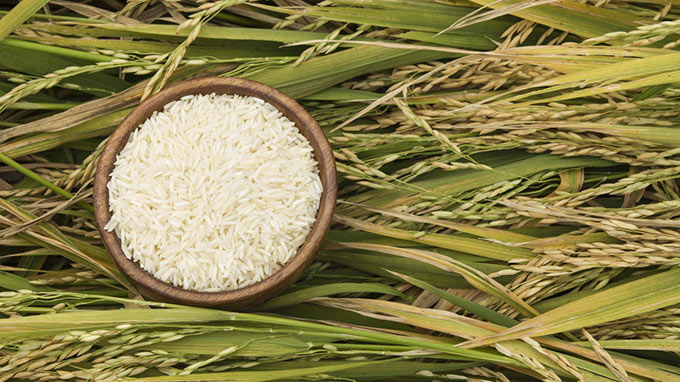
Other Popular Indian Grains
Wheat is the second most commonly eaten grain in the Indian vegetarian diet. Consumption of wheat, and wheat flour, can be traced back 5,000 years in India.
The most common use of wheat flour is for flatbreads, such as roti , chapati, and naan. There are also different types of porridges, such as South Indian upma made with different varieties and preparations of wheat and other grains.
Sweets, such as halva, are also made from sooji, a fine, granular meal made from wheat endosperm.
Barley, millet, and corn are important grains in India. Their use is mainly associated with poor, rural regions, or with health conscious cooks who wish to add more nutrition to their diets. These grains are often ground, and used to make porridges and flatbreads.
The use of barley, called jowar in Hindi, can be traced back over 3,000 years in India.
Millet, known as bajra in North Indian, and ragi in South India, comes in two forms, finger millet and pearl millet.
Corn, known as makkai, is ground into flour and mixed with other grains for flatbread. It is also eaten fresh, on the cob, as a treat. My husband likes his corn with fresh lemon and chaat masala spice, which is a sweet and savory spice masala.
Pulses (Dal)
First of all, what is a pulse? A pulse is the dried seed of a legume. Examples are beans, peas, lentils, and chickpeas.
The Indian vegetarian diet gets a significant part of its nutrition from pulses, and the consumption of pulses is the biggest difference (aside from the spices) between the Indian vegetarian diet and Western diets.
In India, pulses are commonly referred to as dal, or dhal. A dal is usually in the form of a soup or stew, which is served with rice or flatbread.
In India, pulses are commonly referred to as dal, or dhal. A dal is usually in the form of a soup or stew, which is served with rice or flatbread.
Dal is used in seemingly endless ways.
For example, small lentils are browned as a spice to add crunch and flavor to vegetable dishes. They may also be browned and ground into masala spice powders, which are then mixed with rice as a flavoring, or with oil to create a dipping sauce.
Flours made from dal are also used for batters, such as in deep-fried pakoras, or they are soaked, ground, and left to ferment, as in dosa batter.
Not surprisingly, the variety of pulses used in Indian cuisine far surpasses what most people are familiar with.
While the availability of pulse varieties is increasing in mainstream supermarkets in the West, it is certain that some of the amazing Indian dal included on this website will need to be purchased online or at an Indian grocery store.
Visit The Ultimate Guide to Indian Dal (coming soon) to see photos for easy identification, as well as online source links to make it easy for you to buy Indian dal.
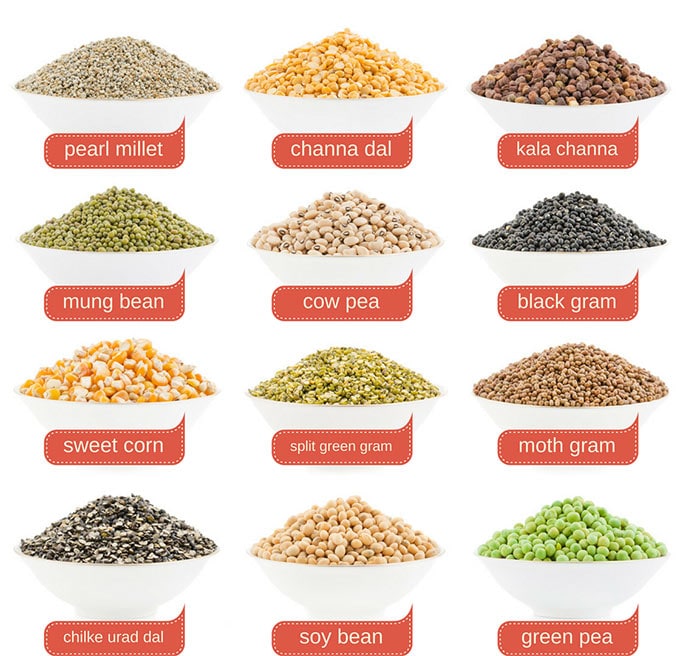
I have to address here that I know that some people are reluctant to embrace pulses because they think it leads to flatulence.
Three things about this: First, flatulence is more prevalent with larger beans, like kidney beans, and most pulses used in Indian cooking are small. Second, soaking the pulses ahead of time makes them infinitely more digestible.
In fact, soaking brings dried pulses back to life. It activates their enzymes and allows their nutrients to be more easily absorbed into the body.
And third, many of the spices used in the Indian vegetarian diet address this issue naturally. I have not found it to be a problem.
Pressure cookers make cooking pulses an absolute breeze.
And finally, about the long cooking time for dry pulses. When I first met my husband's parents in India, and they agreed to the marriage, one of the first things they did was take me to the kitchen store to buy implements for cooking.
To my surprise, I was sent home with three simple pressure cookers. The pressure cookers are the toggle top kind, and they were inexpensive.
I soon experienced that pressure cookers make cooking pulses an absolute breeze. I use one almost every day. The pressure cooking time is measured by the number of whistles, with small beans getting soft and yummy in like 6 minutes.
If you want to explore using pressure cookers at home, seePressure Cooked Food: How to Use a Pressure Cooker Safely, for more details about how to use one worry-free.
If you aren't ready to use pressure cookers, or you don't want to take that step, no problem. Instructions for cooking using the saucepan method are included in every recipe.
[thrive_leads id='1356']
Dairy
Dairy in India is nothing like in the United States.
Perhaps the most important difference is the way the general population understands cows. The cow is revered as a selfless provider, similar to mothers everywhere, and so cows are often referred to as "the mother."
The majority Hindu religion forbids the killing of cows, and tolerance is practiced toward cows to such an extent that they are allowed to roam freely on city streets.
Most are tended by cow herders, but others are fed by religious devotees. When a cow arrives at one's doorstep, it is seen as a duty and an honor to feed the cow.
Some lucky cows are decorated and blessed by priests, and they play a role in religious rituals.
Even for those in India who are non-Hindu, cows are a fixture of life, and so it is not surprising that the Indian vegetarian diet makes full use of dairy.
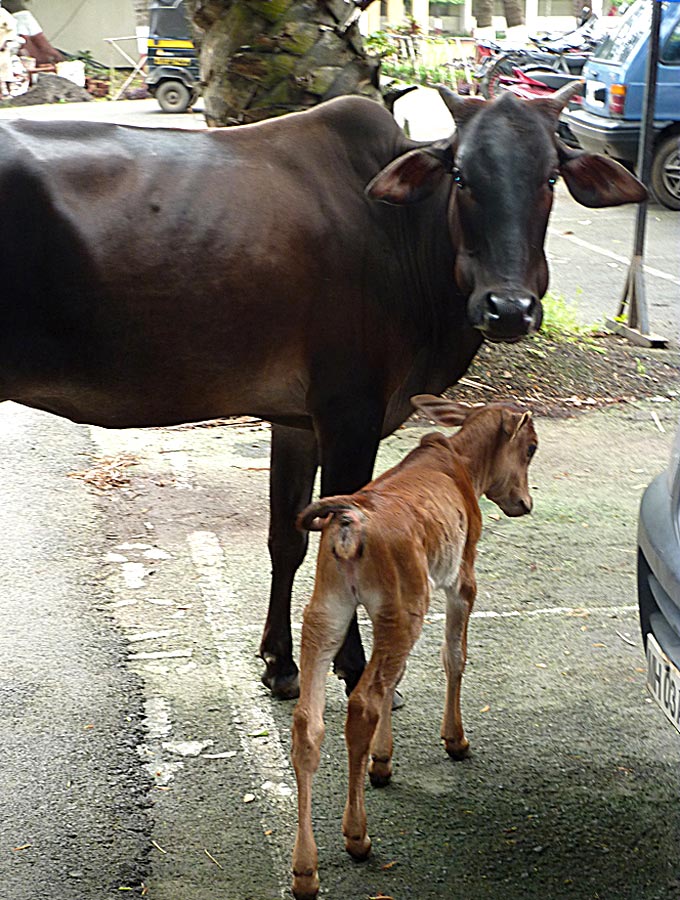
Unlike in the West, where there are hundreds of cheese varieties, in India there is basically only one kind of cheese. It is called chenna when soft (often used for desserts), and paneer when solid.
Both versions start the same way, with whole milk. It takes just a few minutes to make Indian cheese at home. You simply heat the milk to boiling temperature, add a bit of lemon or vinegar, and stir to separate the curds from the whey.
The curd becomes chenna or paneer, depending on whether you knead it or press it respectively. I will post a recipe for making paneer soon, as it is most commonly used.
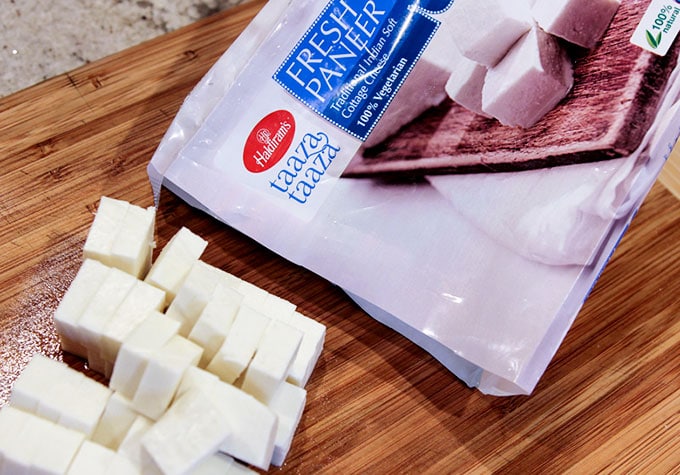
Paneer, the flavor of which is mild and pleasant tasting, has a satisfying, chewy texture. Paneer is used sparingly, and mostly in Northern regional dishes.
It is high in protein, and very satisfying for vegetarians. You will find recipes that use paneer on this website.
Yogurt, frequently referred to as dahi or curd, is an important ingredient in numerous dishes. In South India it is mixed with plain rice and served as a last course to cool the palate.
Yogurt is frequently mixed with vegetables, fruits, and/or spices to create a condiment or salad called raita. It is also used as a binder for the spices in the popular tikka masala dishes.
Buttermilk, frequently consumed with spices added, is also common. Yogurt and buttermilk are often made at home on a daily basis.
Indians consume ghee rather than butter, and ghee is a very special kind of oil. Ghee can be purchased or made at home. Visit this page to learn about 10 Healing Benefits of Ghee.
Ghee is still made from scratch in many Indian households, from butter that is made from scratch, from cream that is skimmed off the top of whole milk that is delivered to the home fresh daily, or obtained from one's household cow.
My mother-in-law always says her son cherishes her homemade ghee. Just today my brother-in-law showed me via Skype video a spoonful of homemade ghee mixed with sugar.
As my mother-in-law looked on with a huge smile, he consumed it, performed a happy dance, and expressed his wish to "drown in this ghee."
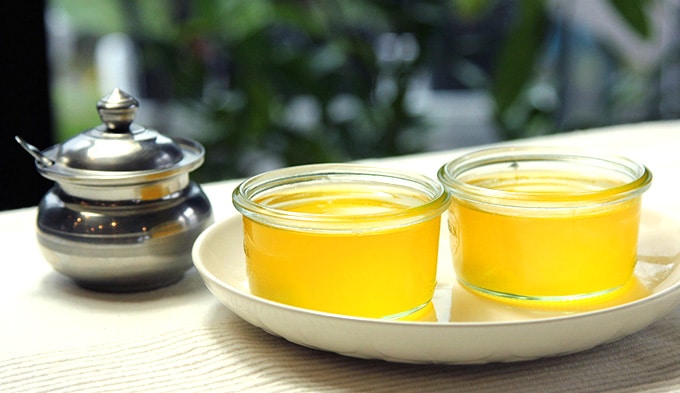
Although many Westerners understand ghee to be clarified butter, it is not exactly. It is similar, but there are important differences.
Ghee is made by simmering butter for a good while on low heat until the milk solids settle and brown on the bottom of the pot, imparting a nutty taste.
The pure, golden ghee is strained and all the milk solids are removed in the process. Clarified butter is not strained. It is skimmed. All milk solids are not removed, and the milk solids are not browned as with ghee.
Ghee has a semi-solid consistency at room temperature, similar to coconut oil. Because there are no milk solids in ghee, it has an extremely high smoke point (450 degrees Fahrenheit) and it is safe for high heat cooking.
Ghee tastes great mixed with steaming hot basmati rice, or drizzled on dal for added depth of flavor and nutrition.
It is also lovely as a base for cooking whole grain porridges. Ghee is considered one of the most sacred foods in India, and one of the most healing.
Click to read the 10 Healing Benefits Of Ghee .
All recipes that call for ghee.
Vegetables
Farmers in India do not have access to cold storage or refrigerated transportation, so they must bring the harvest to market immediately and sell it. This makes for the absolute freshest produce.
Unfortunately, there is also a lot of waste, but that is another story.
Most Indian families purchase what they need for a day or two from a local store, stall, or cart. Vegetables are sold in open markets in every street and neighborhood, so one is never far from the essentials.
Many Indians refer to a "curry" as a vegetable dish. It means either a sauté of some sort with spices added, to be eaten with flatbread, or a vegetable stew in a sauce, to be eaten with rice.
Many Indians refer to a "curry" as a vegetable dish. It means either a sauté of some sort with spices added, to be eaten with flatbread, or a vegetable stew in a sauce, to be eaten with rice.
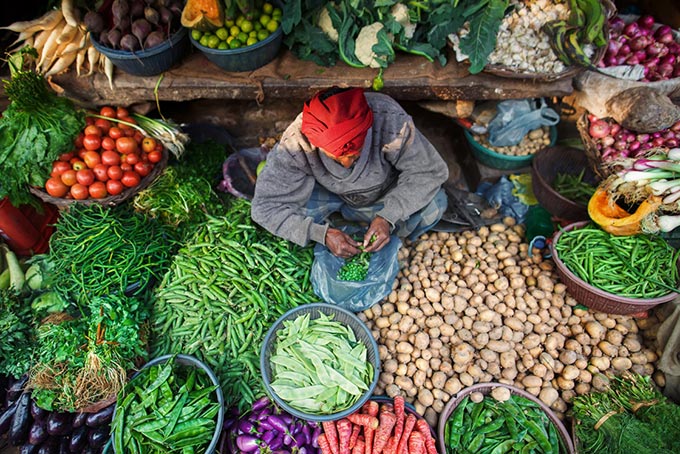
There are not many fresh salads in the Indian vegetarian diet. If they are there at all, they will usually be very simple, such as shredded carrot and cabbage, or sliced onion, lemon, daikon radish, and green chiles.
Raita, the spiced yogurt preparation, can contain fresh vegetables, and I regard it as a kind of side salad, perhaps because of its cooling quality.
When living in India, and eating only Indian cuisine, I found that the diet lacks for vegetables. The main dish is almost always grain and pulse, with spicy vegetables on the side.
Sometimes the grain or pulse dish has vegetables in it, but there is no such thing as roasted vegetables, or vegetable tarts, or vegetable lasagna, or crepes, where the vegetables take center stage.
Ditto for a big salad as a meal. So this is an area where I intend to innovate a lot on this website, because I think the diet is better with more vegetables.
I should mention that pulses are actually classified by the USDA as vegetables because of their fiber, folate, and potassium content. This fact aside, pulses are just not the same as fresh vegetables.
The most commonly used vegetables in the Indian vegetarian diet are potatoes (aloo), eggplant (bringal), okra (bindi), spinach (saag), cauliflower (gobi), tomato (tomatar), onion, fresh green peas (matar), green beans (barbati), plantains, cabbage, cucumber, and bell peppers (capsicum).
Less common are white radish (mooli), fresh fenugreek (methi), pumpkin, bitter melon, mustard greens, drumstick, and beets.
Of these, drumstick, bitter melon, and methi are not regularly available in Western grocery stores.
I have found that all manner of greens, summer squashes, winter squashes, green onion, leeks, red radishes, and basil go well with Indian cuisine, so I frequently include them.
Fruit
A note on fruit. Mango is by far the most popular fruit in India. The mango lassi, made with yogurt, is famous, but there are also mango desserts, mango pickles, mango curries, and mango dals.
Many tasty savory preparations use unripened, green mangos for a tart flavor.
Tamarind, a sweet and sour fruit, is commonly used as a souring agent in South Indian cooking.
Dried fruit, such as raisins, figs, dates, and apricots, are also used in select desserts, sweet flatbreads, and savory rice dishes.
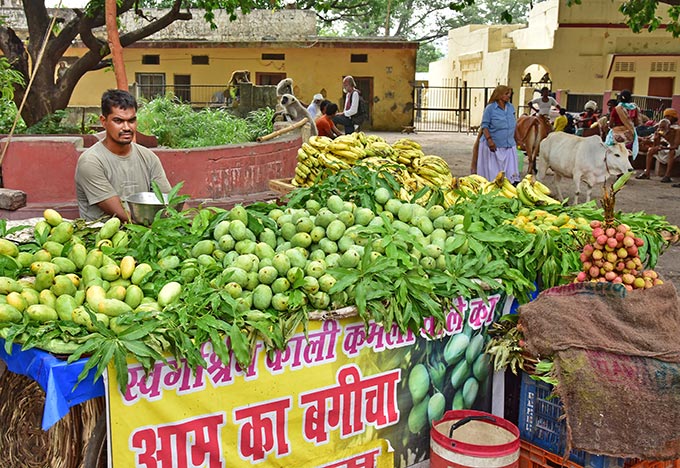
Masala Magic
I will not lie to you, once you have your quality ingredients on hand, Indian food is all about the spices!
An important distinction: I am talking about flavor, and not necessarily heat. Any dish can be made flavorful without heat.
The heat is always up to you, as it primarily comes from the chiles, the garlic, and the ginger. Garam masala can also pack a bit of a punch if you use a lot.
For vegetarians, Indian spices are your best friends. They contain loads of helpful properties to aid in digestion and the assimilation of nutrients.
For vegetarians, Indian spices are your best friends. They contain loads of helpful properties to aid in digestion and the assimilation of nutrients. My father-in-law once advised me to put turmeric in every dish.
Every dish? Really? I later learned it is pretty much in every dish. Once I learned for myself, he didn't have to tell me. Turmeric is so good!
For more information about individual spices, and how to use them, get your Guide to Indian Ingredient Substitutions .
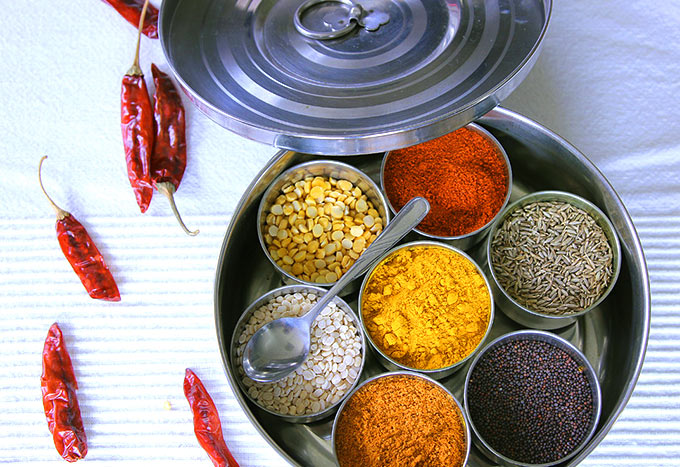
Conclusion
If you enjoyed this post, you may also enjoy my food culture post, Vegetarianism in India.
In this post, I write about the popularity of vegetarianism in India, the religious origins for the sacred cow, how varied landscapes create cuisine, and how historical influences contribute to cuisine.
I'd love to hear from you in the comments, or share it with your friends.
For more Buttered Veg lifestyle and culture content, follow me on Pinterest, Facebook, Instagram, and Twitter.

Name of Indian Vegetarian Diet
Source: https://www.butteredveg.com/the-indian-vegetarian-diet/